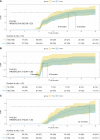Optimal timing of GnRH antagonist initiation in IVF-ET: a retrospective cohort study on advanced maternal age women
- PMID: 38375197
- PMCID: PMC10875460
- DOI: 10.3389/fendo.2024.1340230
Optimal timing of GnRH antagonist initiation in IVF-ET: a retrospective cohort study on advanced maternal age women
Abstract
Background: Several studies have compared the effects of fixed and flexible gonadotropin releasing hormone antagonist (GnRH-ant) protocols during in vitro fertilization and embryo transfer (IVF-ET). However, which GnRH-ant initiation strategy is better remains controversial. Moreover, no studies have assessed the optimal timing of GnRH-ant initiation in women of advanced maternal age (AMA).
Methods: In this retrospective cohort study, a total of 472 infertile women aged ≥ 35 years old undergoing their first IVF cycle from August 2015 to September 2021 at a tertiary academic medical center were recruited, of whom 136 followed fixed GnRH-ant protocol and 336 followed flexible GnRH-ant protocol. The primary outcomes measured were the cumulative live birth rate (CLBR) per IVF cycle and the time to live birth (TTLB) from the date of oocyte retrieval. Cox proportional models were used to calculate the hazard ratio (HR) and 95% confidence interval (CI) of CLBR regarding GnRH-ant timing.
Results: No significant difference in CLBR was found between the fixed and flexible GnRH-ant groups (27.9% vs 20.5%, p=0.105). The TTLB was also comparable between groups (10.56 vs 10.30 months, p=0.782). The Kaplan-Meier analysis for CLBR also showed comparable results between groups (P=0.351, HR=0.83; 95%CI: 0.56-1.23). After establishing a multiple Cox proportional hazard model, the fixed GnRH-ant group still had comparable CLBR with the flexible GnRH-ant group (HR=0.85; 95%CI: 0.53-1.38; P=0.518). Subgroup and sensitivity analyses also demonstrated similar results.
Conclusion: GnRH-ant protocols can be tailored to the needs of AMA women, and timing of GnRH-ant initiation can be adjusted flexibly.
Keywords: Cox proportional hazard model; advanced maternal age; cumulative live birth rate; fixed GnRH-ant protocol; flexible GnRH-ant protocol.
Copyright © 2024 Han, Zhou, Xu, Ai, Song and Sun.
Conflict of interest statement
The authors declare that the research was conducted in the absence of any commercial or financial relationships that could be construed as a potential conflict of interest.
Figures


Similar articles
-
Cumulative live birth rates after one ART cycle including all subsequent frozen-thaw cycles in 1050 women: secondary outcome of an RCT comparing GnRH-antagonist and GnRH-agonist protocols.Hum Reprod. 2017 Mar 1;32(3):556-567. doi: 10.1093/humrep/dew358. Hum Reprod. 2017. PMID: 28130435 Clinical Trial.
-
Comparison of the cumulative live birth rates after 1 in vitro fertilization cycle in women using gonadotropin-releasing hormone antagonist protocol vs. progestin-primed ovarian stimulation: a propensity score-matched study.Fertil Steril. 2022 Oct;118(4):701-712. doi: 10.1016/j.fertnstert.2022.06.012. Epub 2022 Aug 6. Fertil Steril. 2022. PMID: 35940929
-
Cumulative live birth rates between GnRH-agonist long and GnRH-antagonist protocol in one ART cycle when all embryos transferred: real-word data of 18,853 women from China.Reprod Biol Endocrinol. 2021 Aug 12;19(1):124. doi: 10.1186/s12958-021-00814-0. Reprod Biol Endocrinol. 2021. PMID: 34384445 Free PMC article.
-
A study to determine the efficacy of controlled ovarian hyperstimulation regimen using a gonadotropin releasing hormone agonist versus antagonist in women of advanced reproductive age with varying degrees of oocyte reserve on outcome following in vitro fertilization-embryo transfer.Clin Exp Obstet Gynecol. 2013;40(2):191-2. Clin Exp Obstet Gynecol. 2013. PMID: 23971234 Review.
-
GnRH antagonist versus long agonist protocols in IVF: a systematic review and meta-analysis accounting for patient type.Hum Reprod Update. 2017 Sep 1;23(5):560-579. doi: 10.1093/humupd/dmx017. Hum Reprod Update. 2017. PMID: 28903472
Cited by
-
Fixed versus flexible gonadotropin releasing hormone antagonist protocol in women with polycystic ovary syndrome undergoing in vitro fertilization: An RCT.Int J Reprod Biomed. 2024 Oct 14;22(8):617-626. doi: 10.18502/ijrm.v22i8.17230. eCollection 2024 Aug. Int J Reprod Biomed. 2024. PMID: 39494117 Free PMC article.
-
Does the Timing of Antagonist Treatment Influence Cycle Outcomes in Unexpected Low Responders of POSEIDON Class 1 and 2?J Clin Med. 2025 Mar 12;14(6):1901. doi: 10.3390/jcm14061901. J Clin Med. 2025. PMID: 40142709 Free PMC article.
-
Comparison of pregnancy outcomes and safety between cetrorelix and ganirelix in IVF/ICSI antagonist protocols: a retrospective cohort study.Front Reprod Health. 2025 Apr 14;7:1492441. doi: 10.3389/frph.2025.1492441. eCollection 2025. Front Reprod Health. 2025. PMID: 40297130 Free PMC article.
References
Publication types
MeSH terms
Substances
LinkOut - more resources
Full Text Sources
Medical

